The 2017-18 season wasn’t a highlight for Kris Letang. Coming off of major neck surgery which caused him to miss the majority of the 2016-17 season and playoffs, the 31-year-old had an inconsistent 2017-18 season. At times, he looked like the player who anchored the Penguins’ defense to the 2016 Stanley Cup but at others, he looked lost. A notable moment was during Game 5 of the Penguins’ second-round series against the Washington Capitals when he left Jakub Vrana unchecked, allowing him to score the go-ahead goal in the third period.
For most of his 11 NHL seasons, Letang has been the Penguins’ number one defenseman and is among the best at his position. He’s finished top-ten in Norris Trophy voting five times – including a third-place finish in 2013 and fourth place in 2016 – while showcasing an offensive ability matched by few rearguards.
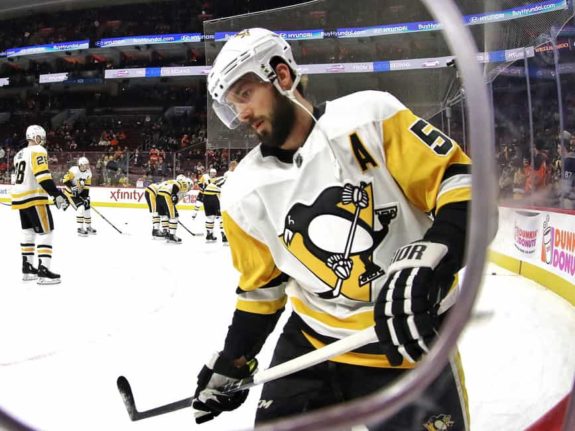
On the other side, Letang has been criticized because of his tendency to turn the puck over, his defensive miscues, cap hit and injury history. The eight-year, $58 million contract he signed in 2013 carries a cap hit of $7.25 million, ninth among NHL defensemen. There are a number of older and less productive players such as Ryan Suter, Shea Weber and Dustin Byfuglien above him in average annual value (AAV). While his injury history and defensive lapses cause problems, the good generally outweighs the bad when it comes to Letang.
For what reasons will Letang bounce back in 2018-19 and why should there be cause for concern?
Reasons to Believe: Offensive Ability & Luck
Letang’s offensive ability was evident from his time with Val-d’Or of the QMHL, where he posted 152 points in 170 games over three seasons, but his numbers didn’t immediately translate to the NHL. During his first three-plus seasons in Pittsburgh, Letang had just 79 points in 219 games. He did this while playing mostly second pair minutes and on the second power play unit, as evidenced by his 20:07 time on ice per game (TOI). It wasn’t until the departure of the Penguins’ longtime top defender Sergei Gonchar following the 2009-10 season that Letang began to break out as an offensive star.
In 465 games since the beginning of the 2010-11 season, Letang has recorded 358 points (75 goals, 283 assists) while averaging 25:16 TOI per game as the Penguins top rearguard. Letang’s point-total is sixth among defensemen and is higher than Ducan Keith (346), Drew Doughty (336), Victor Hedman (344) and John Carlson (327) despite playing a minimum of 87 fewer games than the players mentioned. He also leads Penguins blueliners in points over the last eight seasons. Paul Martin—who hasn’t played in Pittsburgh since 2014-15—is second with 109 points in 297 games.
By season, here are his point totals and points per game averages:
- 2010-11: 50 points in 82 games (.61 PPG)
- 2011-12: 42 points in 51 games (.82 PPG)
- 2012-13: 38 points in 35 games (1.09 PPG)
- 2013-14: 22 points in 37 games (.59 PPG)
- 2014-15: 54 points in 69 games (.78 PPG)
- 2015-16: 67 points in 71 games (.94 PPG)
- 2016-17: 34 points in 41 games (.83 PPG)
- 2017-18: 51 points in 79 games (.65 PPG)
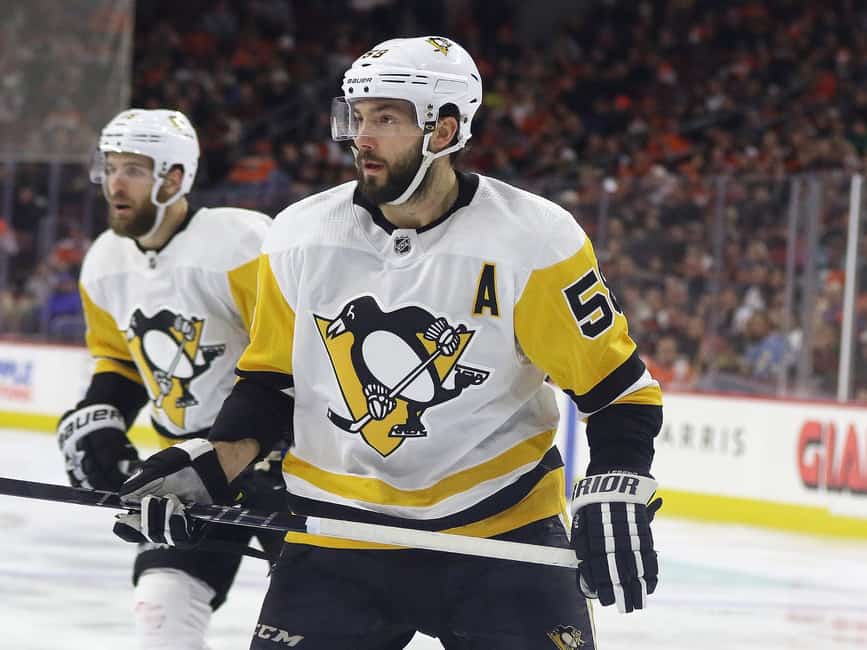
Letang’s playoff production has also been among the best in the game in the same span with 57 points—12 goals and 45 assists—in 76 games, one point behind the Chicago Blackhawks’ Keith who’s played 11 more games. His .75 points per game rank first among blueliners who’ve played at least 25 games.
Here are those numbers:
- 2010-11: Four points in seven games (.57 PPG)
- 2011-12: Five points in six games (.83 PPG)
- 2012-13: 16 points in 15 games (1.07 PPG)
- 2013-14: Six points in 13 games (.46 PPG)
- 2014-15: DNP – Concussion
- 2015-16: 15 points in 23 games (.65 PPG)
- 2016-17: DNP – Neck Surgery
- 2017-18: 11 points in 12 games (.92 PPG)
Letang’s 51 points in the regular season (18th among defensemen) and 11 points in the playoffs (fourth) were viewed as a down season for him. A down season isn’t really the correct term, it was more of a tale of two seasons.
Letang was a mess through most of the seasons first half both offensively and defensively. It would be one good game, one bad game, and his team felt the effects of it. On Jan. 1, the Penguins were 17th in the league in goals for with 109 (2.73 per game) and had surrendered the third-most goals in the league at 127 (3.18 per game). It had the team in danger of missing the playoffs as they sat seventh place in the Metropolitan Division with a 19-18-3 record. Back in February, THW’s Mike Necciai wrote about the rollercoaster that was Letang’s season and pointed out a glaring issue from his first half.
He’s a guy that you want taking chances because of his ability to generate so much off the rush and recover quickly, but that wasn’t the case throughout the first half of 2017-18. In other words, he wasn’t Kris Letang.
After New Years, Letang began to be more consistent and it helped the Penguins turn their season around. The team scored 161 goals (3.84 per game), the most in the league and cut their goals against to 121 (2.88 per game), 19th in the league. The improvements helped the Penguins post the fourth-best record in hockey (28-11-3) during the second half to clinch a playoff spot for the 12th consecutive season.

While inconsistent last year, Letang was still the engine that made the Penguins offense move. In 1,442 minutes at five-on-five, the Penguins had a CF% of 55.07 and FF% of 55.18 with him on the ice, ninth and seventh among defensemen (with at least 1,000 five-on-five minutes) respectively. At high danger, the Penguins had 319 shot attempts with Letang on the ice, fifth among blueliners and his HDCF% of 54.53 ranked him 18th. He was also on the ice for 767 scoring chances, first among defensemen and second among all skaters (Connor McDavid was first with 775), while his iSCF of 103 was 18th among defensemen.
Only two of 14 players who spent 100 or more minutes with Letang, (Riley Sheahan and Tom Kunhackl) had a CF%, FF% or SCF% below 50 percent. Essentially, you could put any combination of players on the ice with Letang and they’d likely net positive possession numbers.
Letang’s value despite a down season was apparent, and he was the leader among Penguins defensemen in Goals above replacement (GAR), which measures how many goals a player adds to his team relative to a replacement level player. Here’s how he ranks among all NHL defensemen in GAR, and the breakdown of his value offensively and defensively at five-on-five.
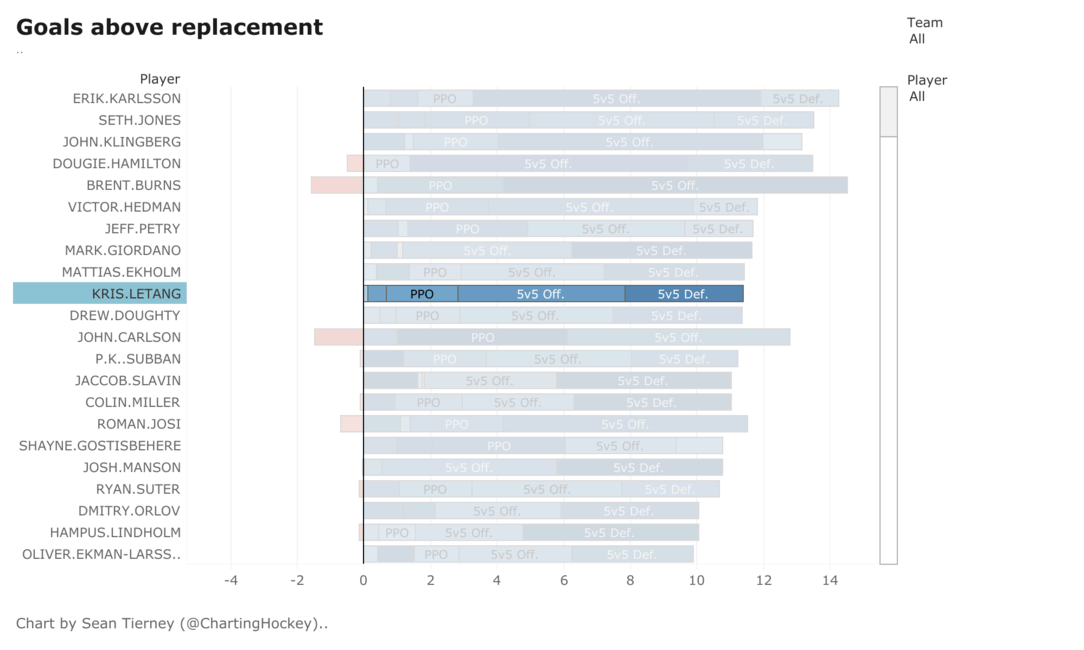
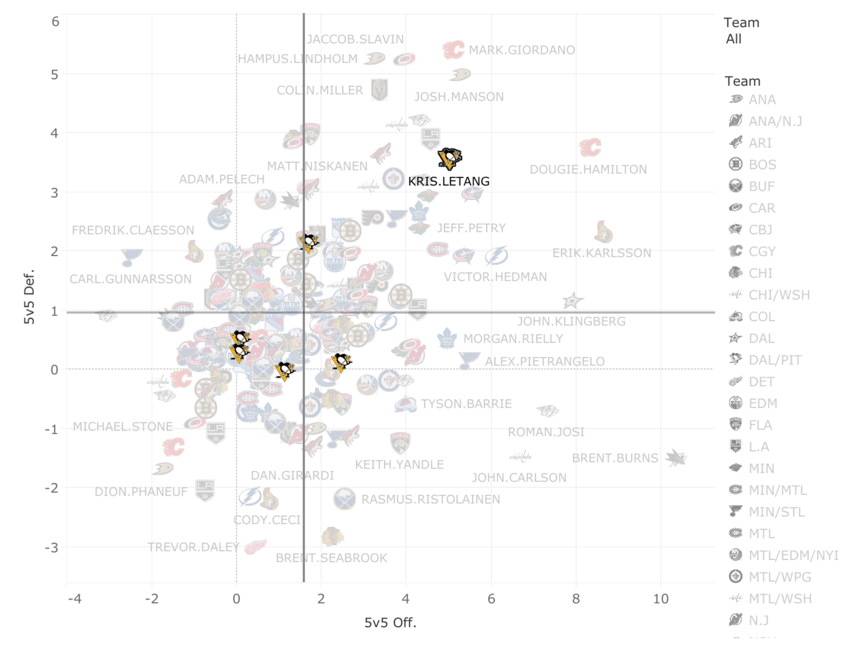
Despite how valuable he is, Letang was on the ice for 76 goals against at five-on-five, compared to just 54 goals for. Just the third time in his career he’s been on the ice for more goals against than for. It’s a significant difference from his xGF of 69 and xGA of 55.
What happened? Part of it has to do with Letang’s play in his own end but the central blame can be placed on the Penguins’ goaltending. His on-ice save percentage (on-ice SV%) of .887 was the worst among defensemen and second worst among all skaters. For context, in 2015-16 and 2016-17, Letang’s on-ice SV% hovered around the .920 mark at five-on-five and has been fairly consistent for a majority of his career.
It isn’t fair to blame Letang for a lousy year from Penguins goalies. As the three currently on the roster (Casey DeSmith, Matt Murray and Tristan Jarry) posted a five-on-five SV% of .913. In 2015-16 and 2016-17, that number was .930 and .926, respectively. Suffice to say, it was an anomaly and Letang’s numbers should return to normal with a good season from Murray.
The team‘s top pairing of Letang and Brian Dumoulin felt the misfortune of the Penguins goaltending last season. The two controlled 54.7% of the shot attempts in 1069 minutes together, fifth among pairings that played over 800 minutes together.
Despite their strong possession number, they were on the ice for 54 goals against and just 42 goals for, a considerable difference from their xGF of 49.98 and xGA of 41.88. Letang and Dumoulin ranked 17th in GF/60 with 2.36—their xGF/60 of 2.81 ranked fourth— and their GA/60 of 3.03 ranked 22nd, while their xGA/60 of 2.35 ranked 12th. All suggesting the pairing deserved a kinder fate than they received.
Here’s how the two stacked up against other pairings in terms of shot rates.
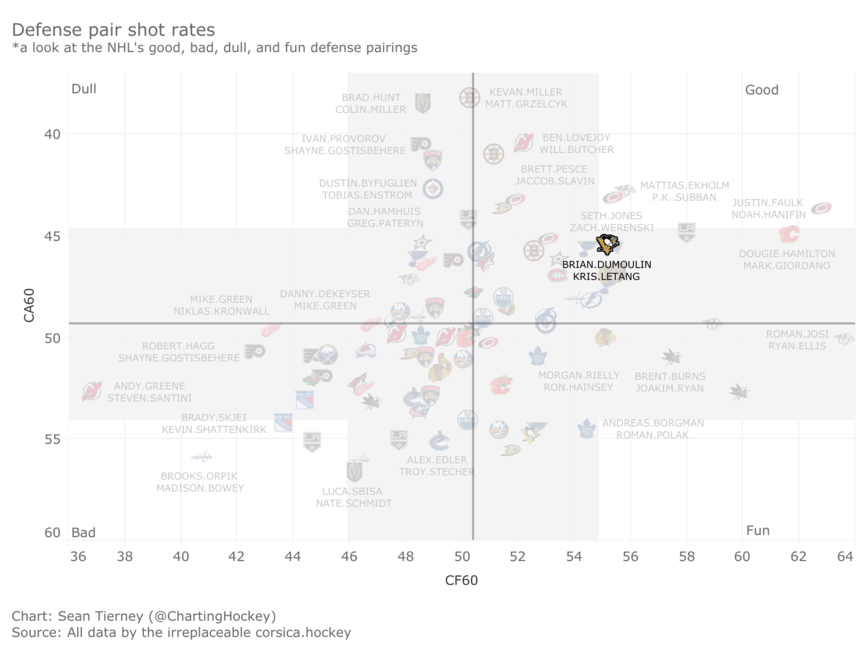
Another thing people point to is his turnovers and he has a number of them, it looks worse on the surface than it does in reality. Letang had 89 turnovers last season, more than one per game, but he didn’t even crack the top 10 among defensemen which included Keith Yandle, Brent Burns, Jake Gardiner, Jeff Petry, Aaron Ekblad, Carlson, P.K. Subban, John Klingberg, Mike Matheson and Ivan Provorov. It looks more like an All-Star team than it does the turnover leaderboard.
Of those players, only Burns, Yandle and Carlson played more minutes than Letang (2000:58). Additionally, he wasn’t even the most turnover-prone player on his team, as Evgeni Malkin (2.96) and Sidney Crosby (2.69) both had a higher i/GVA60 than Letang’s 2.67. When a player has consistent possession of the puck and plays a high-risk, high-reward brand of hockey such as Letang does, turnovers will happen. Lastly, it wasn’t as if Letang didn’t take the puck away from his opponents, as his 53 takeaways were 12th among defensemen, so he did recover from some of his mishaps.
As Adam Gretz of NBC Sports’ Pro Hockey Talk wrote in May, Letang has his faults but generally, he makes up for it.
It basically comes down to this: He is going to make some mistakes, but as long as the positive plays outweigh the negative plays you have to to take the bad with the good.
Causes for Concern: Injury History and Age
Letang has a lengthy injury history and it’s arguably the most concerning history among the team’s stars. He suffered a stroke at the age of 26 in early 2014, in addition to three diagnosed concussions, which includes two in four months during the 2011-12 season and a herniated disc in his neck that required surgery. Our Julia Stumbaugh dove deeper into Letang’s injury history back in January of 2017.
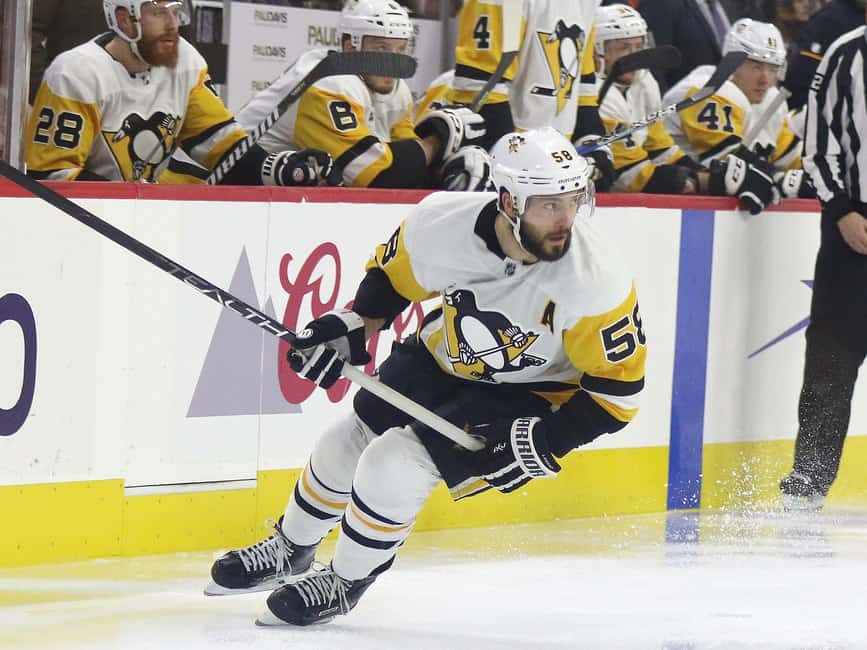
He’s been on the receiving end of a number of controversial hits in his career from Max Pacioretty’s blindside hit that left him concussed in 2011, to Zac Rinaldo driving him into the boards in 2015, to Shane Doan’s late hit which concussed him late in the same season, and Ryan Callahan’s hit from behind during the 2016 Eastern Conference Final. It’s clear his body has been through hell and back.
Of course, Letang isn’t the most conservative player and his lapses in judgment make him vulnerable to dangerous hits. While head coach Mike Sullivan has said in the past that he doesn’t want Letang to change his style of play, he’d like him to stop getting hit when there’s no reason for him to be in a vulnerable position.
“There might be an assumption that we’re trying to change the way ‘Tanger’ plays the game. That’s not what the message has been to Kris,” Sullivan said. “It’s been more about making more calculated decisions on when there simply isn’t a play to be made.”
It seemed to have paid off last season as Letang played 79 games, the most since 2010-11, although it was just the fifth time in his career that he’s played over 70 games in a season. Durability isn’t his strong suit, and it’ll likely continue to be a concern for the Penguins throughout the rest of his career.
Another cause for concern is age. Letang turned 31 in late April, and it now starts placing him in the territory of a more rapid decline in play. Much like everything else in life, there are exceptions to the rule but usually, the average hockey player peaks around 25-26 and declines gradually until around age 30. As an athlete moves through their 30s they can naturally begin experiencing a sharper drop in play. It’s something to watch out for as Letang gets deeper into his 30s, although, as an elite level player, it’s unlikely his decline will be as severe as what a mid-tier player would typically experience.
The Verdict: A Bounce Back Season Is in the Cards
There are legitimate reasons to be concerned about Letang’s play. It’s possible that the remainder of his career is just a slightly better version of what we saw last season, compared to the elite play of the last 11 years. Although, there are a number of reasons to believe he will return to his elite form in 2018-19.
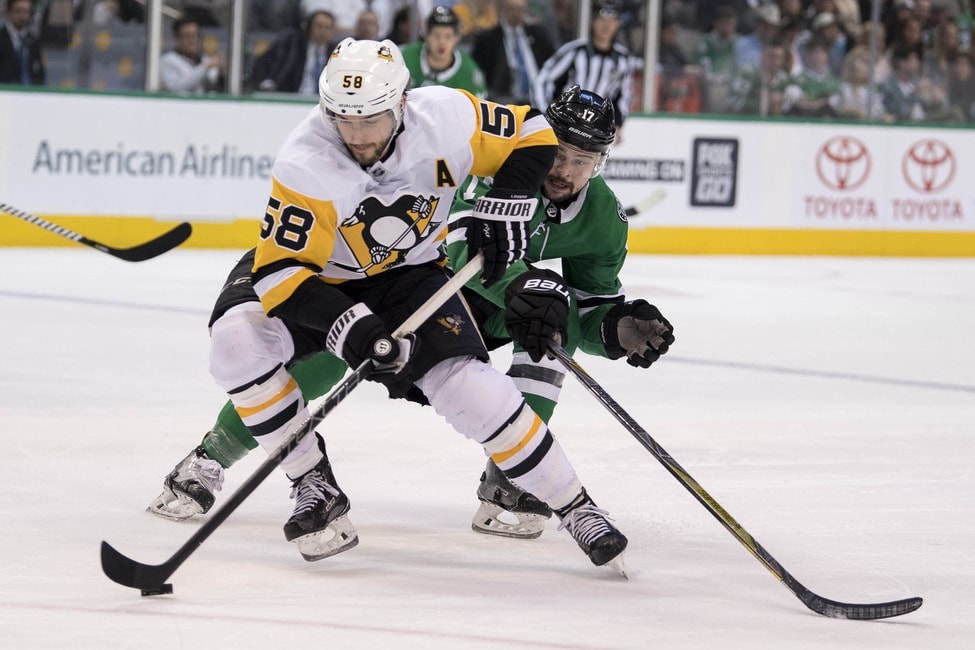
One reason is he’s now almost 18 months removed from a major surgery. Another is he had a full and healthy offseason for the first time in a long time. Although there should be more than just hope he bounces back. The Penguins need Letang to have a rebound season because they’re a better team with him at his best. Letang’s the longtime anchor of their blue line, as well as the key to the offense, it moves as he does.
The following is an example of how valuable he is.
While the Penguins won the Cup without him in 2016-17, they were more lucky than good. Having Crosby and Malkin helps, but the Penguins were outplayed at five-on-five and lived off their power play, bad goaltending from their opponents and their goalies playing at an elite level. The defense couldn’t get the puck out to the forwards and the team was routinely stuck in their zone. This was on full display during Game 1 of the Stanley Cup Final, as the Penguins went 37 minutes without a shot on goal. Their inability to move the puck traced back to the absence of Letang.
Only two players who played over 100 minutes in the 2017 playoffs—Chris Kunitz (51.21%) and Phil Kessel (50.16%)—were able to control even half of the shot attempts at five-on-five. The team as a whole was out-attempted 1216 to 1042 at five-on-five. When Letang played 23 of 24 games during the 2016 run, thirteen players controlled over half the attempts, and the Penguins out-attempted teams 1215 to 1140 at five-on-five en route to the Cup.

Letang’s puck-moving ability and creativity at both ends of the ice is an asset, as is his ability to eat minutes while maintaining an elite level of play. A return to that form would allow everybody on the blue line to slide into a less demanding role, benefitting the Penguins from top to bottom.
Being in top shape would be the first step to a return to form. After missing almost eight months of training and game action there were concerns Letang wasn’t up to full speed throughout the season, and he admitted to it after the playoffs.
“I thought I was going to be fine,” Letang said. “I thought I was going to get over the hump maybe in the first few weeks of the season. It didn’t happen that way. It took a little bit more time.”
He seems to be up to speed now, as he said last week.
How does Kris Letang feel now compared to this time a year ago, when he was returning from neck surgery? “A million times better.”
— Matt Vensel (@mattvensel) September 11, 2018
Marc-André Fleury was written off during his time in Pittsburgh, Malkin’s been written off, even Crosby was written off at one point. Each time they returned to their elite forms and Letang has more than earned the right to join them. After all, he’s already surpassed the expectations set for him after being selected in the third round of the 2005 draft. As Necciai wrote back in January 2016, Letang is irreplaceable to the Penguins.
My question for those that feel the Penguins should trade Kris Letang is simple; Who do you replace him with? The other part of that is how do you replace him for less money? His annual cap hit always seems to be the central point of argument but if you want a defenseman that can contribute the way he can, you have to pony up the cash for them.
He isn’t the best player on the Penguins, but he is the most important one. If Crosby is out, Malkin is right there to pick up the slack, and if Malkin is out, Crosby is there. Sure, Dumoulin and Justin Schultz are capable of playing 25 minutes a night for a stretch of games, but neither of them could do it for an entire season and change the game the way Letang can.
Pending his health, and with the return of some luck. Letang is going to bounce back and it’s going to make the Penguins a difficult team to play against.
*Advanced Statistics from Natural Stat Trick and Corsica.Hockey